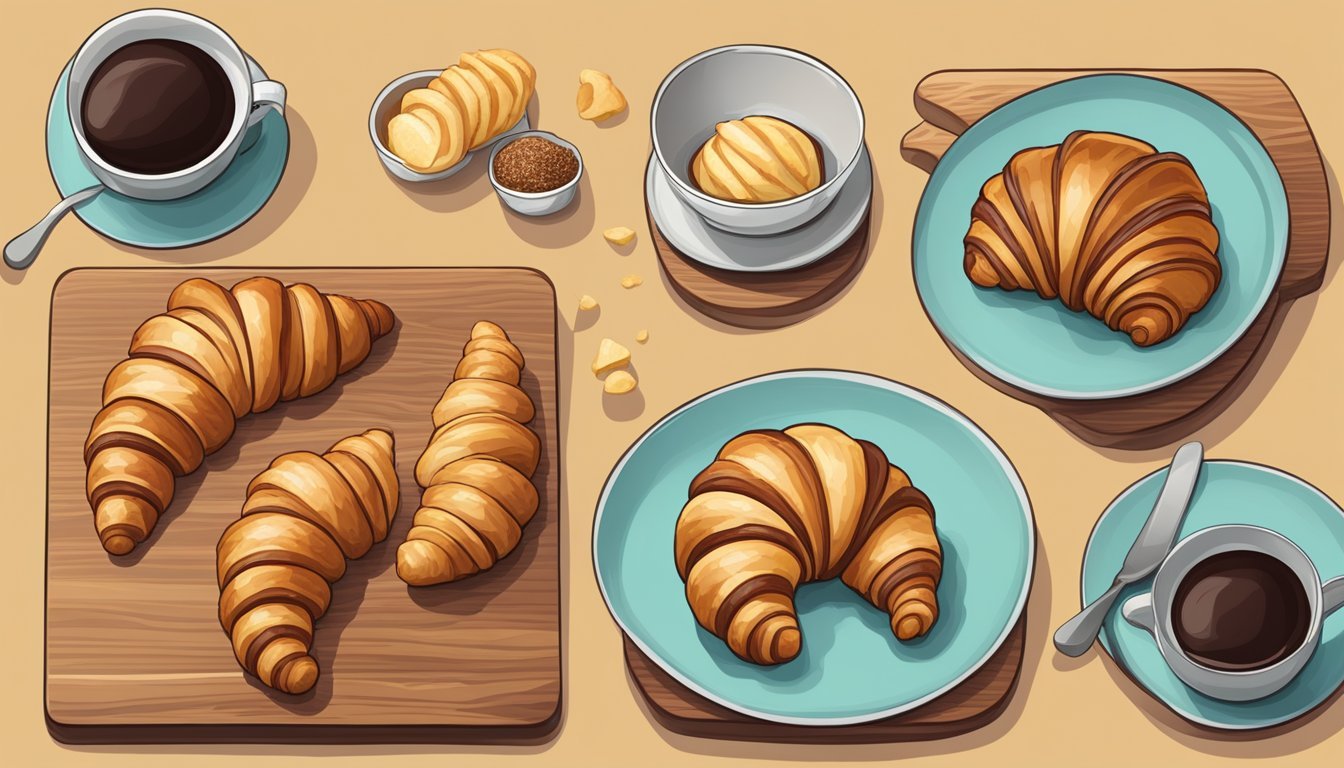Croissant Substitutes
5 Tasty Alternatives for Your Breakfast Menu
Croissants, with their buttery layers and flaky texture, are a staple in many breakfast menus across the globe. Originating from France, these pastries have become synonymous with indulgence and comfort. However, due to their high butter content, they are often not the healthiest option for daily consumption. Those seeking healthier alternatives without compromising too much on taste have a range of options to consider.
Whole grain variations of pastries can offer a more nutritious start to the day. By using whole grains such as oats or quinoa, individuals can increase their intake of fiber while enjoying a similar satisfaction to that of a traditional croissant. Nut inclusions provide a boost of healthy fats and dried fruits can add natural sweetness, creating a balanced and flavorful breakfast choice.
For those adhering to a vegan diet or with dairy restrictions, vegan croissants present a viable substitute. These are crafted using plant-based fats and non-dairy milks, such as soy or almond, and may employ natural sweeteners like maple syrup for glazing. Vegan croissants aim to replicate the light and airy qualities of the classic recipe while aligning with dietary preferences or requirements.
History and Types of Croissants
The origin of the croissant can be traced back to 17th century Austria, where the kipferl, a crescent-shaped pastry, was first created. It's believed the kipferl is the ancestor of the French croissant. The transformation into the croissant known today occurred when the pastry was brought to France, where its recipe and shape evolved.
French bakers adopted a technique known as lamination to craft the croissant. This involves meticulously folding butter into the dough multiple times to create numerous layers. The yeast-based dough used is similar to puff pastry but differs due to the yeast, offering a more bread-like texture when baked.
In France, two primary types of croissants are distinguished:
Croissant ordinaire: Often made with margarine instead of butter.
Croissant au beurre: Made with pure butter, providing a richer flavor and more tender crumb.
Despite the association with French cuisine, the croissant recipe has continually adapted, leading to a variety of fillings and types, such as:
Type Description Almond Croissant Filled with almond paste and often topped with sliced almonds and powdered sugar Chocolate Croissant Known as pain au chocolat, filled with chocolate bars Ham and Cheese Croissant Filled with ham and cheese, serving as a savory option
Each type of croissant exhibits a balance of flaky exterior and soft interior, contingent on mastering the laminated dough process. The croissant not only reflects a rich history but also a culinary tradition favoring meticulous preparation and quality ingredients.
Understanding Croissant Dough
The mastery of croissant dough involves a delicate balance of precise ingredients and a technique-driven process that results in the dough's signature flaky layers and rich flavor.
Components of Croissant Dough
Croissant dough starts with a mix of flour, water, yeast, salt, and a little sugar. The flour's gluten content is crucial as it provides elasticity, while the yeast initiates fermentation, contributing to flavor and dough rise. Butter is also an essential ingredient, but it is typically incorporated later in the form of a butter block during the laminating process.
Flour: High-protein content for gluten development
Water: Hydrates the dough
Yeast: Leavening agent that causes the dough to rise
Salt: Flavor enhancer and gluten strength regulator
Sugar: Provides sweetness and assists with yeast fermentation
The Art of Laminating the Dough
Laminating the dough involves repeatedly folding and rolling the dough with a butter block to create distinct, thin layers. It starts with encasing the butter within the dough, then rolling it out and folding it in a specific manner. This technique results in multiple layers of dough separated by butter, which will puff up during baking.
Encase butter within the dough
Roll out to a rectangle, maintaining an even thickness
Fold in a letter style, then rotate
Repeat the rolling and folding several times
Croissant Dough Characteristics
The right consistency of croissant dough should be neither too elastic nor too sticky. Properly developed gluten ensures the dough is strong enough to trap the gases released by yeast, while the layering technique makes the dough flaky once baked. It is a fine balance to maintain a dough that is workable but also able to produce the pastry's characteristic layers.
Elasticity: Enough to hold shape and trap gases
Stickiness: Slightly tacky but not overly so
Tips for Dough Preparation
The dough preparation starts with kneading, which can be done with a dough hook on a stand mixer. Resting the dough in the refrigerator wrapped in plastic wrap is crucial for gluten relaxation and butter firmness. Temperature control is key throughout the process to prevent the butter from melting or becoming too hard, which will affect the quality of the layers.
Kneading: Develop the gluten structure
Resting: Relax the gluten and firm up the butter
Shaping and Baking Croissants
Shaping the croissants involves rolling out the laminated dough and cutting it into triangles, which are then rolled from the base to the tip. Before baking, croissants are typically brushed with egg wash to achieve a golden brown finish. They are baked on a baking sheet lined with parchment paper until puffed up and golden with the precisely defined layers visibly separating.
Shaping: Rolling cut triangles into the crescent shape
Baking: Requires a preheated oven and careful timing to achieve the perfect color and texture
Croissant Substitutes and Variations
Exploring substitutes and variations for croissants allows individuals with different dietary needs or preferences to enjoy the flakiness and richness of this classic pastry. Whether opting for vegan, gluten-free, or health-conscious alternatives, or indulging in sweet and savory fillings, there are numerous ways to adapt croissants.
Vegan Croissant Options
Vegan croissants replace traditional butter with vegan butter and use plant-based milks such as almond, soy, or oat milk. An effective vegan egg wash can be made with a blend of these milks and a little maple syrup for color and sheen. Vegan options maintain the flaky texture while being free from animal products, offering both protein and calcium depending on the chosen milks and butters.
Gluten-Free Alternatives
Gluten-free croissants substitute traditional all-purpose or bread flour with gluten-free flour blends. These blends might consist of rice, almond, or other gluten-free flours to ensure the pastry is safe for those with gluten sensitivities, while striving to mimic the light texture that croissants are known for.
Sweet and Savory Fillings
Sweet Fillings:
Sugar enhancements with maple syrup or a sprinkling of icing sugar.
Rich fillings like Nutella or vanilla custard.
Nutty additions using chopped nuts for added texture.
Savory Fillings:
Protein-packed ingredients such as cheese or ham.
Vegetarian options with spinach or mushroom.
Healthier Croissant Choices
For healthier modifications, simple substitutes can be employed:
Whole wheat pastry flour in place of white flour to increase fiber.
Reduction of sugar or replacement with natural sweeteners like maple syrup.
Incorporating nuts or seeds to boost protein and calcium content.
Home Baking Tips and Techniques
Home baking croissants requires precision and patience, especially when it comes to kneading, rolling, and shaping. The recipe one follows is the blueprint for success and should be adhered to strictly.
Before starting:
Ensure all equipment is on hand, including a sharp knife, spatula, pastry brush, pizza cutter, and ruler.
Parchment paper is a baker's ally, providing non-stick surfaces for baking sheets and ease of cleaning.
Laminating the Dough:
Begin with a well-chilled, pliable butter block.
Accurately measure and trim the dough and butter using a ruler and pizza cutter for sharp edges.
Encase butter in dough and seal edges to prevent butter from escaping.
Shaping:
Flour the work surface to prevent sticking when rolling out the dough.
Roll out to a consistent thickness, aiming for an even rectangle, which ensures uniformity in the final product.
When shaping the croissants, a gentle stretching of the dough corners can contribute to the classic crescent shape.
Baking:
Preheat the oven as the recipe dictates.
Use a spatula to transfer the shaped dough onto baking sheets lined with parchment paper, allowing ample space for expansion.
Apply an egg wash using a pastry brush to achieve a golden sheen.
Remember to watch the pastries carefully as they bake, looking for a golden-brown color as an indicator of doneness. A successful bake will result in flaky, buttery, and irresistible croissants.
Storing and Reviving Croissants
Proper storage can maintain a croissant's freshness, while thoughtful reheating can restore its original glory. Here are specific methods to preserve and enjoy croissants, ensuring they remain as delightful as when first baked.
Preserving Freshness
Room Temperature:
Store croissants at room temperature for up to 2 days.
Use an airtight container to prevent moisture and staleness.
Refrigeration:
Croissants can last in the refrigerator for 3-5 days.
Wrap them in plastic wrap or place in resealable bags to retain moisture.
Freezing Techniques:
For extended freshness, freeze croissants for up to 2 months.
Wrap in foil or plastic wrap, then place in freezer bags to avoid freezer burn.
Reheating and Serving Suggestions
Oven Method:
Preheat oven to 375°F (190°C).
Place the croissant on a baking sheet for 2-3 minutes.
Air Fryer Approach:
Preheat Air Fryer to 350°F.
Heat the croissant for a short time ensuring space for air circulation.
Toaster Use:
For a quick refresh, lightly toast the croissant until it's warm.
Making the Most of Leftover Croissants
Breakfast Sandwiches:
Slice a croissant and fill with eggs, cheese, and ham or bacon for a hearty breakfast.
Bread Substitute:
Use leftover croissants in place of bread for a unique spin on sandwiches or French toast.
Alternative to Scones:
Serve with jam and clotted cream as a luxurious alternative to scones.





